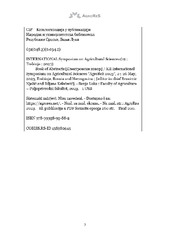| dc.creator | Dolijanović, Željko | |
| dc.creator | Oljača, Snežana | |
| dc.creator | Simic, Milena | |
| dc.creator | Dragičević, Vesna | |
| dc.creator | Jovanović, Zoran | |
| dc.date.accessioned | 2023-11-15T08:25:50Z | |
| dc.date.available | 2023-11-15T08:25:50Z | |
| dc.date.issued | 2023 | |
| dc.identifier.isbn | 978-99938-93-88-2 | |
| dc.identifier.uri | http://rik.mrizp.rs/handle/123456789/1293 | |
| dc.description.abstract | The maize cultivation trial was conducted at the Research and Experimental
Field "Radmilovac" of the Faculty of Agriculture in Belgrade in 2022 on the
soil type luvic chernozem in completely randomized blocks. The cropping
system included tillage with a disk harrow at 25-30 cm with complete
incorporation of winter wheat crop residues and tillage with a harrow before
sowing. Basic fertilizer was applied in the fall at 500 kg ha-1 NPK (15:15:15).
The following microbiological fertilizers were used for top dressing in spring:
Biofertilizer ("Slavol", manufacturer "Agrounik" Serbia) with 5 l ha-1
in two
treatments and Eko lame with 10 l ha-1
in 3 treatments. The top dressing in the
control variant was done with nitrogen fertilizer AN at the rate of 60 kg ha-1 N.
Maize varieties (ZPSC 666) were used. The maize was grown in a six crop
rotation. Statistical analysis confirmed that top dressing had a greater effect on
weediness of maize. The weed community in maize crops consisted of 15 weed
species, with terophytes dominating: Stellaria media (L.) Vill., Veronica
persica Poir. and Sonchus oleraceus (annual species) and Agropyrum repens
(L.) Beauv., Cirsium arvense (L.) Scop., Convolvulus arvensis L.and Sorghum
halepense (L.) Pers. (perennial species). The obtained results show that the
highest number of weeds, weeds per species, fresh and air-dry biomass were
recorded in the control variant. The statistically lowest values for the number
of weed plants per species and fresh biomass, as the most important parameters
of weed infestation, were recorded in the treatment with Eko lame. The
differences in weed population in the variants with microbiological fertilizers
were not statistically significant, while there were statistically very significant
differences compared to the control. The use of microbiological fertilizers
affected the initial faster development of maize plants and increased
competitiveness against weeds. | sr |
| dc.language.iso | en | sr |
| dc.publisher | Banja Luka : University of Banja Luka, Faculty of Agriculture | sr |
| dc.rights | openAccess | sr |
| dc.rights.uri | https://creativecommons.org/licenses/by/4.0/ | |
| dc.source | 12. International symposium on agricultural sciences "AgroReS 2019", Trebinje, 24-26.05.2023. - Book of abstracts | sr |
| dc.subject | competition | sr |
| dc.subject | weed | sr |
| dc.subject | maize | sr |
| dc.subject | top dressing | sr |
| dc.title | The effect of different microbial fertilizer on the weediness of maize | sr |
| dc.type | conferenceObject | sr |
| dc.rights.license | BY | sr |
| dc.citation.spage | 85 | |
| dc.citation.epage | 85 | |
| dc.identifier.fulltext | http://rik.mrizp.rs/bitstream/id/6400/bitstream_6400.pdf | |
| dc.identifier.rcub | https://hdl.handle.net/21.15107/rcub_rik_1293 | |
| dc.type.version | publishedVersion | sr |


